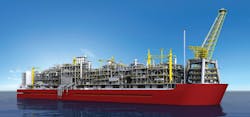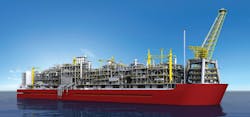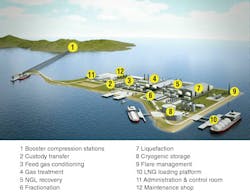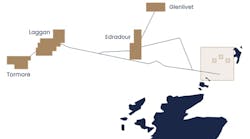Chuck Miller
Emerson Process Management
Floating liquefied natural gas (FLNG) plants have both advantages and disadvantages, and they present unique challenges when it comes to automation.
An FLNG strategy has a number of application-specific advantages over an onshore facility. In the first place, it offers a way to monetize gas in remote areas or geopolitically challenged regions. This type of vessel takes what is normally spread out over about 50 acres of land in a land-based LNG plant and stacks it into a space that measures about 1,200 ft-by-400 ft (365 m-by-121 m). The result is great complexity in a small space and a considerable engineering challenge.
A traditional onshore LNG facility uses a mature and proven technology; numerous projects have been executed, and the technical risk has been minimized. The processes used on an FLNG vessel are generally based on newer designs than those used in onshore facilities - designs that may be unproven in a marine environment. This requires a rethinking of how technology is deployed because there is no commercial-ready reference, and risk management strategies have yet to be proven.
An FLNG facility is built in a dry dock, rather than on site, which can give more control over construction activities and labor cost compared to a remote worksite with limited infrastructure, although so far this has not translated into any particular saving in time: both onshore and offshore facilities tend to take about five years to complete. An FLNG vessel can be expected to have 50-year design life, with a long operating period before dry-dock inspection and overhaul. It offers flexibility in the types of processing equipment installed to accommodate a variety of gas conditioning requirements. It acts as a moveable midstream asset, and avoids costly pipeline infrastructure to move gas ashore.
A potential challenge comes from the fact that there are only a few shipyards equipped to build an FLNG vessel, although so far this has not led to any difficulties. Perhaps mitigating this is the common practice in the offshore and marine industries of building a vessel's topsides equipment in modules that are constructed separately and then installed onto the ship. This process is still lengthy.
On the commercial side, onshore LNG facilities follow proven commercial models; they generally involve long-term sales agreements (which are a necessity for financing such a project). This need for long-term sales agreements has resulted in cases of consumer nations, like Japan, Korea, Taiwan, India, China, and others investing in the projects. This commitment by stakeholders has proven useful in attracting attention from FLNG developers hoping that these projects to access stranded gas deposits will be able to justify the use of these new technologies.
Challenges at sea
The environment on a ship is considerably different from that on land, and it affects design, construction, and operations. On a basic level, everything on an FLNG facility must be rated for marine service, which increases costs. Once at sea, the movements of the ship - roll, pitch, and yaw - can affect the LNG process as a whole, reducing the performance of the cryogenic process. In addition, there can be sloshing of the liquids involved, including the LNG itself as well as condensate and wastewater. On top of that, the deep sea water intake that provides the cooling water must be considered, if for no other reason than the need to filter out debris, and the need to clean the filters that do that.
One of the largest challenges to the use of an FLNG facility comes in offloading. While a fixed pipeline can be used to deliver LNG from an onshore facility to a loading dock, an FLNG vessel is constantly in motion - as is the ship onto which it is loading the product. The waves do not carry both ships up and down at the same time, leading to multiple design decisions. Should offloading be done using flexible hoses or hard arms? Will the FLNG and the transport vessel tie up side by side or stern to bow? What will be the restrictions on allowable wave height? Will longer-term variations in wave heights impose seasonal loading windows? The designers of the FLNG vessel must make these decisions, and the automation system supplier must accommodate these different designs, providing the emergency response systems that are automatically deployed in case of an event.
It is the responsibility of the captain of the receiving ship to monitor the loading process, to initiate emergency procedures if necessary, and move to a safe distance until the situation is resolved.
Costs
While one might think that the development of a traditional LNG project has predictable lead times - after all, the permitting process is known, the infrastructure needs are known, and storage and loading methods are straightforward - in reality, most of these megaprojects experience significant overruns in both time and cost that reach into the billions of dollars. FLNG projects are no better, and are often worse. Because fewer of them have been built, the risks tend to be greater, there are more unknowns than there are with an LNG.
In addition, approval by the various certification and class bodies that claim jurisdiction can add additional burdens in time and costs. The surest way to minimize such overruns is experience. On the automation side, it is very important to select a supplier that is familiar with the certification process, and that has the capabilities and resources needed to develop the technologies that comply with the class-body requirements of these new processing environments.
There are a number of technologies and processes for liquefying natural gas available to FLNG designers; the choice of a particular process has a great effect on the efficiency and operational cost of the facility. It can also have a significant effect on the automation supplier's scope of work.
In the final analysis, differences in cost between an FLNG and an onshore facility are secondary to the main driving force for FLNG development. An FLNG facility makes it possible to economically get at gas that is too far from shore to be practically harvested and sent to land. It is this that can induce financiers to risk their capital for a 10-year payback.
Another consideration is that, as FLNG assets become more available, they will potentially cut the time to first production, and can be up and running while more permanent onshore assets are being developed.
Safety
The biggest safety challenge in any floating facility is that if things go really wrong, there are limited escape options. This means that reliability of the safety systems is even more critical than it is for a land-based facility.
It is the responsibility of the control equipment supplier to design and install a fit-for-purpose safety system. This system must protect the ship's equipment, the environment, and the lives of all the people present. It must also have very high integrity and a very low probability of failure on demand. Development of such a safety system requires a full functional analysis and a quantified safety review by the design team.
Challenges in this area include complexity, escalation issues, the need to prepare for such contingencies as unexpectedly high pressure from some gas wells, fire, and explosion survivability, structural support issues, and the fact that the ship's living quarters are generally built on top of volatile storage facilities. It is a best engineering practice to distribute the safety system in independent protection layers so that there is not a potential common point of failure and a single event cannot impact the safety functions of the whole.
Certification of safety systems is essential, and it is vital not only to put in all necessary safety measures for all foreseeable problems, but also to think outside the box and envision worst-case scenarios that appear to be almost impossible. There have been production platform disasters in the past decade caused by failures that the designers had not realized could ever happen, and that resulted in loss of life, environmental disasters and enormous fines.
Rules and approvals
In addition to changes in process design, the safety rules used with shore-based LNG facilities are inadequate for offshore. There are control systems that operate as an umbrella over top of the whole ship, keeping track of hundreds of different variables, and if these variables go out of the consensus safety zone, the safety system must take the appropriate action, which can range from a complete shutdown in the worst case to taking the system back into recycle or making sure that all the permissives are in line and correct before the start of offloading LNG or any number of different scenarios.
Even if a company has plenty of experience with FPSO vessels, integrating topsides and hulls, and handling topsides and subsea, in the eyes of the approval bodies FLNGs are new, and require a complete set of type approvals. ABS, Bureau Veritas, Lloyds Register, DNV GL, and TÜV must be satisfied before the ship can operate, and obtaining certification from all of these bodies is time-consuming and expensive.
Integration issues
FLNGs have multiple integration challenges. The two main ones are integration of the topsides with the hull and integration of the topsides with the subsea equipment.
In integrating the automation architecture, it is a good idea to choose a design in which autonomous automation systems are distributed in each local equipment room (LER) and hull, and each LER and hull automation system can be operated independently during construction and commissioning. This will allow the shipyard to install, test, and operate the hull independently of the topsides automation and safety system. Similarly, all the topsides modules can be tested locally before they are installed on board the ship.
The master control system (MCS), where the basic control is performed, is often implemented using a separate programmable logic controller for many functions; the MCS also includes an operator interface. This equipment is generally specific to the buyer of the FLNG facility, with a proprietary design. It has been Emerson Process Management's experience that this adds unnecessary complexity, and it is better to design the MCS communications as a subsystem to the distributed control system.
The main challenges in integrating topsides and undersea equipment are in communications; the links through the umbilical tend to have fairly narrow bandwidth; which means that the controls must be set up to manage data flow between topsides and subsea with considerable care so that urgent data is transferred quickly, but no data is lost.
Support
Manning levels are a balancing act between number of people aboard the vessel and the level of automation required. In theory, it would be possible to completely automate the vessel and all its systems, and have just one person to oversee everything, but this is clearly impractical. Most FLNG units are designed to have anywhere from 100 to 200 people on board; these will be backed up by more people on shore.
There are practical limits on the number of personnel that can be kept aboard an FLNG vessel. Space is limited, costs are high, and there is always a certain level of hazard. This is especially true for support personnel, who may not be needed constantly, but when needed, are needed immediately. One solution to this conundrum is to institute integrated operations (iOps), which makes use of teams of experts in an onshore operation, with the assistance of specialists located at bases around the world. The offshore facility is joined to the onshore facility by broadband audio/video links. The iOps center can monitor FLNG operations and diagnose problems in real time, at any hour of the day or night. It can provide remote operations and remote monitoring; integrated/centralized maintenance; production planning and optimization; and assistance with business operations.
These remote operations depend heavily on broadband communications, but they require that large amounts of real-time data be available. This data comes from two main sources. The first is the use of a large numbers of monitoring sensors connected to a central hub and to each other via a wireless mesh network. This makes possible the gathering and monitoring of data from process and non-process sensors located throughout the ship and its equipment. The second is the ability to bring back all the inherent diagnostic data available in the smart field devices that monitor and control the processes. Combining the data from the network of asset monitoring sensors and the internal diagnostics of the process instrumentation with the expertise and databases at the iOps center can greatly enhance the reliability of the on-board systems and overall operation of the FLNG facility.
Conclusion
FLNG is still an unproven application that requires partnering with companies that have the resources and capability to solve problems as they are identified. It is the ability to resolve those problems with technologies and solutions that will keep these projects on schedule and on budget, and will make them part of the mainstream asset choice. It is important to remember that until these FLNG projects have been operating for 10 years, no one will truly understand all the complexities involved. The closest one can come to an answer to successfully automating such a system is to choose an automation supplier with the expertise, experience and capabilities to make it work. •





